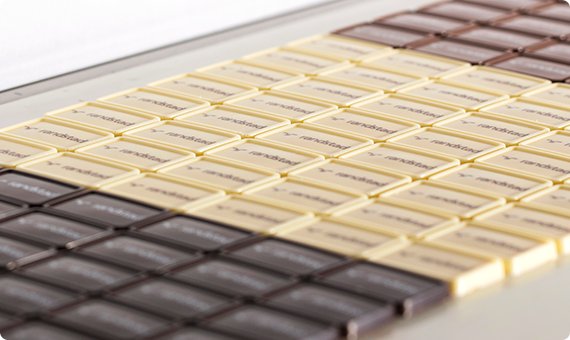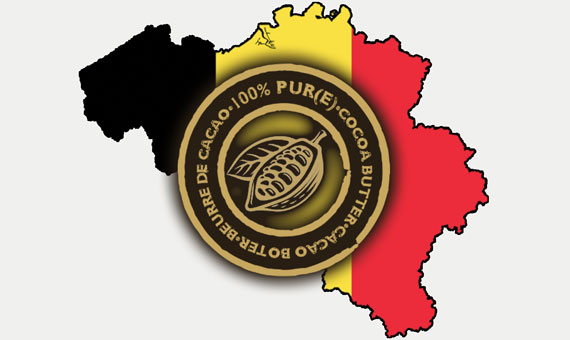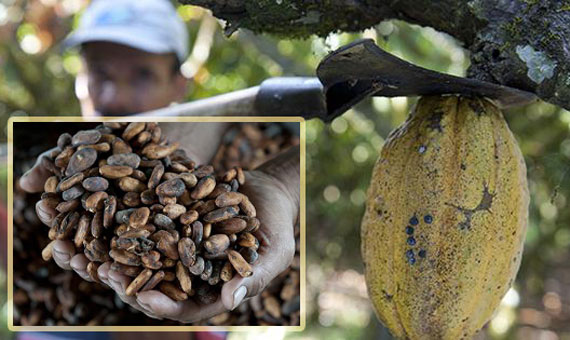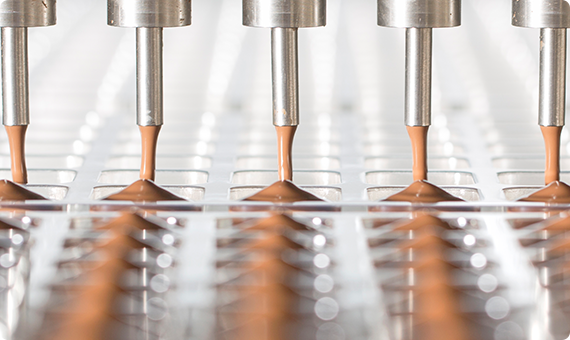A unique printing technology
CandyCard developed unique printed personalized Belgian chocolate promotional gifts. They allow you to present yourself and your company in an impressive and delicious way. Most other printed chocolate products use a transfer medium to apply the printing to the chocolate. This transfer medium usually contains allergens such as azo colors, egg, corn, etc. and is less sustainable due to the use of a plastic carrier film. At CandyCard, only a thin layer of decorated white belgian chocolate is applied directly into the molds of the chocolate tablets and pralines or filled chocolates using the exclusive in-mold printing system developed in-house. Only natural food pigments and food-safe ingredients are used. Afterwards, our delicious Belgian chocolate is poured into the mold. This guarantees that you will always receive the freshest personalized chocolate promotional gifts. Especially since we have an average delivery time of only 10 working days between your order and delivery. The result? A tasty, original, healthy, equitable and sustainable luxury product on which even photos with their many shades or gray scales, shadows and gradations can be reproduced down to the smallest details with truly stunning image quality. For the professionals; We obtain resolutions of 1200 dpi with a lineature of up to 200 lpi on the chocolate. Due to its unique printing technology, you can always recognize all CandyCard chocolate products by their High Definition image quality and by the refined raised rim.
FIND IT ON OUR PRODUCTS OR READ MORE....Your customers appreciate this exclusive culinary gift
We Belgians are rightly proud of our culinary excellence and its worldwide fame. Our delicious waffles, our tasty beers and our renowned Belgian chocolate and pralines or filled chocolates are well appreciated by everyone. What if you wer to give those chocolates or pralines to your important business partners or valued staff members and you could apply your logo or message in HD image quality on the tasty gift? Right! With this personalized chocolate promotional gift you would an unforgettable impression not only with Christmas or Easter celebrations. These delicious treats are always well received at fairs, meetings, company anniversaries or as a gift for customers and employees. Show yourself from your chocolate side and be remmeberde in your customers' sweetest memories.
READ WHY.... OR DISCOVER OUR PRODUCTS
Did you know that CandyCard is a family business? The two brothers, Marc and Frank, work every day with passion and attention to the products in order to put the crown on their work and especially on your brand!
History of Belgian chocolate
History of chocolate
The history of chocolate started in Mesoamerica.
Fermented drinks made from chocolate date back to 450 BC. The Aztecs believed that cocoa seeds were the gift of Quetzalcoatl, the god of wisdom, and the seeds once had so much value that they were used as a form of currency. Originally prepared only as a drink, chocolate was served as a bitter liquid, mixed with spices or mashed corn. It was believed to be an aphrodisiac and empower the drinker.
After its arrival in Europe in the sixteenth century, sugar was added and it became popular in all of society, first among the ruling classes and then among the common people. The word "chocolate" comes from the classic Nahuatl word Xocolātl and has been introduced into English from the Spanish language. In the 20th century, chocolate was considered essential in the rations of American soldiers during the war.
Chocolate and Industrial Revolution
New processes that accelerate the production of chocolate arose early in the industrial revolution. In 1815, the Dutch chemist Coenraad van Houten introduced alkaline salts in chocolate, which reduced bitterness. A few years later, in 1828, he created a press to remove about half of the natural fat (cocoa butter) from chocolate mass, making chocolate both cheaper to produce and more consistent in quality. This innovation along with the addition of melted cocoa butter by Joseph Fry in 1847 introduced the modern era of chocolate. Because this allowed pressed chocolate to be transformed into a new shape, for example to make chocolate bars. A second milestone was reached in 1875 with the creation of milk chocolate. Henri Nestlé had just invented condensed milk, which allowed Daniel Peter, a Swiss like Kohler, to develop the recipe for milk chocolate.
Belgian chocolate
The Belgian chocolate goes back to 1635, when the country was under Spanish occupation shortly after chocolate was brought to Europe from Mesoamerica. By the mid-18th century, chocolate had become extremely popular in the upper and middle classes, especially in the form of hot chocolate. Among them was Charles-Alexander of Lorraine, the Austrian governor of the area. From the early 20th century, Belgium was able to import large amounts of cocoa from its African colony, Belgian Congo. Around 1900, chocolate became increasingly affordable for the Belgian working class. For the first time Belgium began to export more belgian chocolate than it imported in the 1960s, with an exponential growth in exports of "Belgian chocolates" since 1980.
The praline is an invention of the Belgian chocolate industry
Chocolates made in Belgium are usually soft-centered treats with a chocolate shell. They are distinguished from the nut and sugar candies that are popular in France and the United States, which are also sometimes known by the same name. They were first introduced by Jean Neuhaus II in 1912.
Belgium does it better. Production and standards.
The composition of Belgian chocolate has been regulated by law since 1894 to prevent adulteration of the chocolate, with fats other than 100% cocoa butter and therefore of lower quality from other sources. A minimum level of 35 percent pure cocoa was imposed.
Belgian chocolate shows little resemblance to the "chocolate" which in other parts of the world falls under the name chocolate. The key are the ingredients and the purity of the cocoa, which must adhere to strict rules. Master chocolate makers never use cocoa butter substitute fats. European Union law says that to call a product chocolate, it should not contain more than 5 percent substitute fat, which is cheaper than using 100% cocoa butter. This attempt by the European Economic Community (EEC) to introduce minimum standards for the quantity of cocoa butter substitutes across Europe led to protracted negotiations, but the legislation finally adopted in 2003 was enacted in Belgium. considered too flexible. In 2007, the voluntary quality standard (which approximately 90 percent of the chocolate makers in the country adhere to) was introduced by the European Union, which has established certain criteria to define a product like "Belgian chocolate" to be considered .Under this" Belgian chocolate code" refining, mixing and conching must take place in Belgium.
FIND THEM IN OUR PRODUCTS OR READ MORE...From bean to personalized chocolate from CandyCard
The cocoa tree is grown in countries in the narrow subtropical strip around the equator. Specifically in the zone between 23° north latitude and 23° south latitude. The largest cocoa-producing countries are Ivory Coast and Ghana. Cocoa does not like to grow in full sun and is therefore usually grown under the shade of adjacent trees.
It all starts with the flowers that grow on the trunk of the cocoa tree. After fertilization, the flowers grow into a colored fruit. When it is ripe, it is picked by hand using a machete to avoid damaging the trees.
The cocoa beans with pulp are removed from the fruit, fermented and dried in the country of origin. After drying, the majority of the harvest is shipped to Europe and America. There, the beans pass through a breaker that splits the shell so that only the core, better known as the nib, remains. Finally, the nibsare roasted and finely ground - an essential step in achieving good quality chocolate. The result is the cocoa mass. To obtain cocoa butter, which is necessary to lower the viscosity of the chocolate, the cocoa mass is pressed. The result will yield 55% cocoa butter and 45% cocoa powder.
Now it is the point at which the Belgian chocolate specialists employ their magic. There are three vital processes that make Belgian chocolate so unique: selecting the ingredients, refining them, and conching the actual chocolate.
The delicious taste of Belgian chocolate therefore starts with the careful selection of ingredients that are as pure as possible. The best quality of cocoa beans from all over the world are expertly blended. A team of experts analyzes the ingredients to ensure that only the best quality cocoa mass, cocoa butter and other ingredients are used. It goes without saying that in Belgian chocolate we only use 100% cocoa butter and 100% natural vanilla.
The next step is to mix the ingredients. Different raw materials are mixed depending on the type of chocolate. For example, no milk powder is used for dark chocolate, no cocoa mass is added for white chocolate.
Then the chocolate mass is refined. Belgian chocolate is known for its delicacy and easy melting on the tongue. This requires two crucial steps. First, all particles are rolled to the same size (150 microns). Then the chocolate is made even finer, up to 20 microns. Nice detail, the human tongue detects anything larger than 30 microns, which gives an unpleasant sandy feeling.
After grinding, the chocolate is conched. The friction gives the chocolate a homogeneous texture. Also the residual moisture and the volatile aromas evaporate during conching. And the intimate contact between sugar, milk powder and cocoa mass creates 'good'. flavor components. This is a crucial step in achieving the typical taste that characterizes our Belgian chocolate.
In a next step, the viscosity is determined by adding cocoa butter to the chocolate. And this in function of the requested application.
For example, at CandyCard we only use Belgian chocolates that contain a higher content of cocoa butter than the average used chocolate. This way we can make the smallest tablets with refeined raised rims for you.
In our production, this Belgian koeverture chocolate in hardened drop & liquid form is remelted and tempered, which ensures that the chocolate after hardening in our printed molds, shrinks and thus give a good melting behavior in the mouth and creates a beautiful shine on the chocolate together with your logo or photo.
FIND THEM IN OUR PRODUCTS READ MORE...Belgian Chocolate at its best
All CandyCard products are made from the very best Belgian dark, white or milk chocolate. Even more ; we only use the best so-called "couverture" chocolate that have an extra high cocoa butter content. With real Belgian chocolate you pleasantly stimulate the interest of customers or relations. Giving chocolate to a business partner or customer is a symbol of care and positivity. We are happy to help you realize your perfect personalized chocolate promotional gift.
Here you will find the details of our 3 chocolate flavours and our hazelnut praliné filling, from our main Belgian chocolate suppliers Barry Callebaut and Belcolade:
Our milk chocolate
- Ingredients: sugar, cocoa butter, whole milk powder, cocoa mass, emulsifier: soy lecithin (E322), aroma: natural vanilla
- Min. 34% cocoa solids and 22% milk solids
- Allergens: Milk, soy, traces of nuts
- Nutritional values per 100 g: Energy: 2331 kJ / 559 kcal, Fats: 35 g, -of which saturated: 21 g, Carbohydrates: 53 g, -of which sugars: 52 g, Proteins: 7,0 g, Salt: 0.20 g.
- Shelf life: 15 months
- download here the technical sheet
Our dark chocolate
- Ingredients: cocoa mass, sugar, cocoa butter, emulsifier: soy lecithin (E322), aroma: natural vanilla
- Min. 60,5% cocoa solids
- Allergens: soy, traces of nuts and milk
- Nutritional values per 100 g: Energy: 2232 kJ / 536 kcal, Fats: 35 g,- of which saturated: 22 g, Carbohydrates: 42 g, -of which sugars: 38 g, Proteins: 7,4 g, Salt: 0.01 g.
- Shelf life: 21 months
- download here the technical sheet
Our white chocolate
- Ingredients: sugar, cocoa butter, whole milk powder, emulsifier: soy lecithin (E322), aroma: natural vanilla
- Min. 30% cocoa solids and 25% milk solids
- Allergens: Milk, soy, traces of nuts
- Nutritional values per 100 g: Energy: 2401 kJ / 576 kcal, Fats: 37 g,- of which saturated: 23 g, Carbohydrates: 54 g, -of which sugars: 54 g, Proteins: 6.2 g, Salt: 0.22 g.
- Shelf life: 12 months
- download here the technical data sheet
Our Gianduja filling of hazelnut praliné
- Ingredients: sugar, hazelnuts, cocoa butter, cocoa mass, whole milk powder, emulsifier: soy lecithin (E322), aroma: natural vanilla
- Allergens: Milk, soy, nuts
- Nutritional values per 100 g: Energy: 2397 kJ / 573 kcal, Fats: 39 g, -of which saturated: 12 g, Carbohydrates: 48 g, -of which sugars: 39 g, Proteins: 8,9 g, Salt: 0, 10 g.
- Shelf life: 6 months
- download here the technical data sheet
Storage conditions
Since our chocolates are made of a thin layer of decorated white belgian chocolate the shelf life of white chocolate applies for the products nml. 12 months. Chocolate is best kept in a cool, dry and dark place. Ideally at 16 ° C-18 ° C and with a relative humidity less than 50%. Temperature fluctuations (+/- 2 ° C) should be avoided, especially with pralines or filled chocolates to avoid fat bloom. Although the best before date to be consumed for pralines is 6 months, we still recommend ordering pralines in quantities that you can consume within 3 months of delivery date. This to ensure the visual quality from teh pralines (mainly by possible fatbloom caused by with not ideal storage conditions).
FIND THEM IN OUR PRODUCTS WANT TO KNOW MORE...Not only quality but also sustainability and fair
At CandyCard we opt for sustainable and honest ingredients and corporate social responsibility without making concessions on quality.
In the area of food safety, we work fully in accordance with the HACCP standards and Belgian auto-control legislation (Product sampling, upward and downward traceability, &recall procedures). HACCP, short for Hazard Analysis and Critical Control Points, is a risk inventory for food production. These are strict EU standards that contribute to food safety. We leave nothing to chance to deliver your personalized chocolate promotional gifts safely and fresh to you! From development to production, from labeling to packaging and from collection in our workshops to delivery to you, your chocolate gifts are always optimally cared for.
Delicious chocolate starts with the careful selection of ingredients.
Our Belgian chocolate suppliers have strict criteria when it comes to the origin of cocoa beans, using only the best quality for our chocolate. Each country where cocoa beans come from has its own specialties, cocoa varieties and flavors. They only work with specially selected farmers cooperatives with the same harvest and post-harvest processes. Their long-term relationships guarantee consistent high quality.
The future of chocolate depends on a sustainable supply chain
Chocolate has been cherished for thousands of years and those who love the taste are consuming more and more. Despite the growing popularity of chocolate, many environmental, social and economic challenges prevent cocoa farmers from living sustainably. By helping farmers increase the value of their cocoa, delicious chocolate can be enjoyed for generations.
At our chocolate suppliers, they believe that sustainability is a win-win relationship. It offers added value to every actor in the cocoa chain, including farmers, customers and consumers. Several programs have all the classic elements of sustainable certification, but for us superior taste through controlled fermentation of the cocoa beans and a chocolate bonus for farmers is unique.
Responsible purchasing
As a socially responsible company, we always want to buy responsibly by:
1. Environmentally friendly raw materials, packaging, equipment and services that benefit society and provide value for money throughout their life cycle
2. Give preference to suppliers who share our vision of sustainability and work to maintain a more sustainable supply chain
GET A QUOTE




